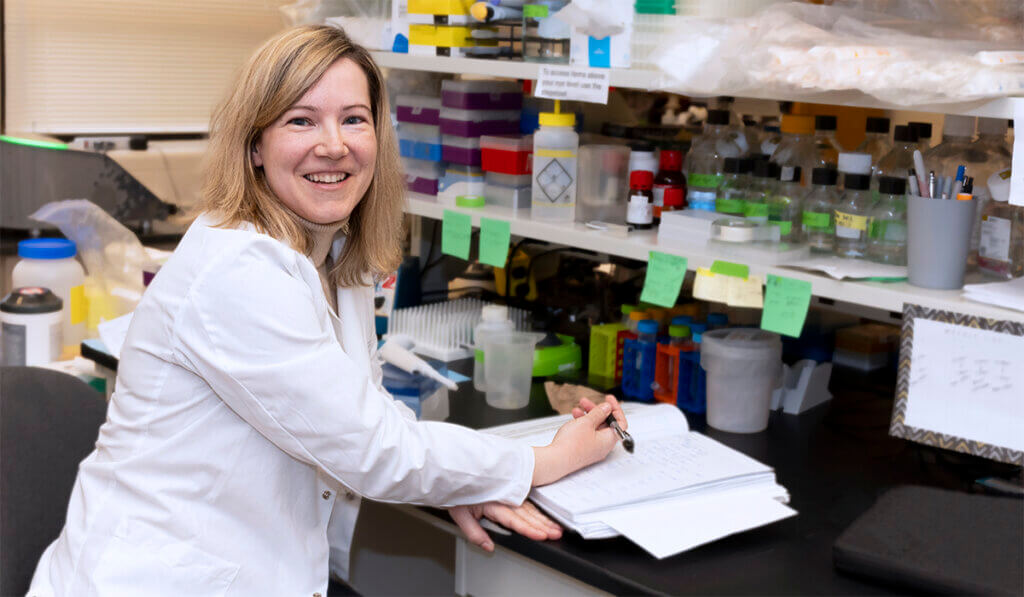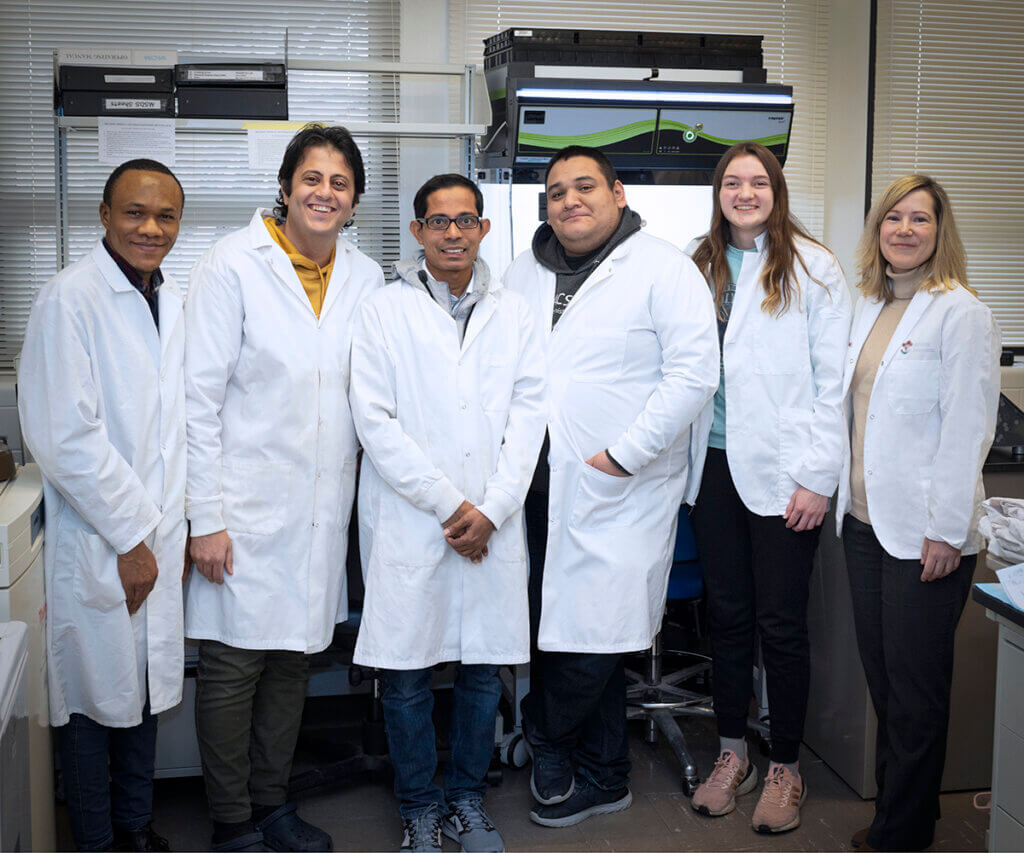
Purdue researchers led by Basic Medical Sciences Department Faculty Member Jessica Fortin have created molecular compounds to inhibit protein aggregation linked with Alzheimer’s disease, Parkinson’s disease, and Type 2 diabetes
Researchers at Purdue University have taken the first steps to treat Alzheimer’s disease, Parkinson’s disease, and Type 2 diabetes by creating multiple patent-pending compounds shown to inhibit protein aggregation associated with those diseases.
According to the Centers for Disease Control and Prevention, as many as 95% of the approximately 38 million Americans with diabetes have Type 2 diabetes and as many as 5.8 million Americans were living with Alzheimer’s in 2020. The Parkinson’s Foundation reports nearly 1 million Americans are living with Parkinson’s.
Dr. Jessica Sonia Fortin is an assistant professor of basic medical sciences, physiology, and pharmacology in the College of Veterinary Medicine and a member of the Purdue Institute for Drug Discovery. She leads a team working on the preparation of new small-molecule compounds and their validation through in vitro studies to inhibit the aggregation of several proteins.
Dr. Fortin has received funding from the EveryCat Health Foundation; the Pharmaceutical Research and Manufacturers of America; and the National Institute on Aging, a division of the National Institutes of Health, to conduct the research.
The role of protein aggregation in disease
Alzheimer’s and Parkinson’s are the two most common neurological diseases. Symptoms include cognitive decline, movement disorders, and premature death. Type 2 diabetes is an endocrinal disease that can lead to circulatory, nervous and immune system disorders. The development of these diseases has a common trait: the aggregation of proteins, including certain hormones.

“In Type 2 diabetes, about 70% of cases involve a hormone called islet amyloid polypeptide, or IAPP, that accumulates in the pancreas,” Dr. Fortin said. “Alzheimer’s disease and Parkinson’s disease are associated with clumps accumulating in specific regions of the brain caused by proteins called tau and alpha-synuclein, respectively. Some forms of dementia are characterized by the presence of both tau and alpha-synuclein aggregated in the brain. There is also an interconnection between Type 2 diabetes and neurodegenerative diseases. Recent studies have found more than one aggregated protein in the pancreas and brain, indicative of the so-called ‘cross-seeding’ effects of these misshapen proteins.”
Dr. Fortin said current methods to treat these diseases focus on alleviating symptoms. But she and her colleagues are targeting IAPP, tau and alpha-synuclein to treat the underlying causes. She said a multi-targeting approach would be the best option for these chronic diseases.
“We aim to offer small-molecule therapeutics that not only prevent aggregation, but also disaggregate already-existing clumps,” Dr. Fortin said. “The body can then eliminate these byproducts and the dual action of these compounds can impede the redistribution of the clumps alongside blood vessels; the risk of such redistribution is intracranial hemorrhage in the brain.”
Creating treatments for Alzheimer’s and Parkinson’s
Dr. Fortin and her colleagues have synthesized a library of small-molecule compounds with similar chemical structures for the treatment of Alzheimer’s and Parkinson’s. They measured the compounds’ activity to inhibit protein aggregation at the micromolar level, or one-millionth of a mole per liter.
“Two compounds significantly inhibited the formation of oligomers, which are polymers that have relatively few repeating units,” Dr. Fortin said. “These compounds cross the blood-brain barrier and reach the brain in rodent models, which is a big step forward. They stop the formation of inclusions, which are made by the aggregation of alpha-synuclein, in a cell-based model run by my collaborator, Dr. Ulf Dettmer at Brigham and Women’s Hospital and Harvard Medical School. We are seeking funding to understand the precise mechanisms of action of these small-molecule terminators of oligomers.”

Dr. Fortin said researchers could administer these Purdue-developed compounds along various pathways by combining them with pharmaceutical carriers like lactose, mannitol, and microcrystalline cellulose.
“This strategy shows promise as a next-step treatment therapy for Alzheimer’s disease and Parkinson’s disease,” Dr. Fortin said. “It also exhibits potential adaptability for other, analogous neurodegenerative diseases like Huntington’s disease, Lewy body dementia, chronic traumatic encephalopathy, or CTE, and transmissible spongiform encephalopathies, or TSEs.”
Creating Type 2 diabetes treatments
Dr. Fortin and her colleagues have discovered three small-molecule compounds that inhibit the formation IAPP, which aggregates in the pancreas of many with Type 2 diabetes.
“These small molecules reduced the aggregation of IAPP at about 25-100 micromolar after one hour. They also inhibit the oligomer formation of IAPP,” Dr. Fortin said. “These molecules work on feline and human form of IAPP and could be developed further for human and feline diabetes. They are nontoxic to mouse and rat cancerous beta cell lines. The mechanisms of their action are still under investigation.”
The next development steps
Dr. Fortin and her team will continue to develop both lines of treatment at laboratories in the College of Veterinary Medicine and the Purdue Institute for Drug Discovery. “We will conduct additional proof-of-concept studies, focusing on optimizing the effect of the compounds,” Dr. Fortin said. “We also will study the compounds’ pharmacokinetics and pharmacodynamics, or how they move within the body and what effects they have on the body. Preliminary data demonstrated that five representative compounds were present in the brain after injection in mice.”
Dr. Fortin disclosed the compounds to the Purdue Innovates Office of Technology Commercialization, which has applied for patents through the U.S. Patent and Trademark Office to protect the intellectual property. Industry partners interested in developing or commercializing the work should contact Joe Kasper, assistant director of business development and licensing — life sciences, at jrkasper@prf.org, about track codes 69967, 69996, 70004 and 70255.
